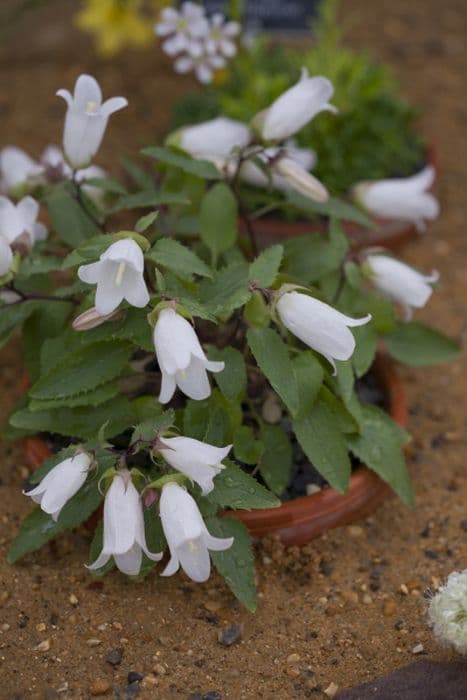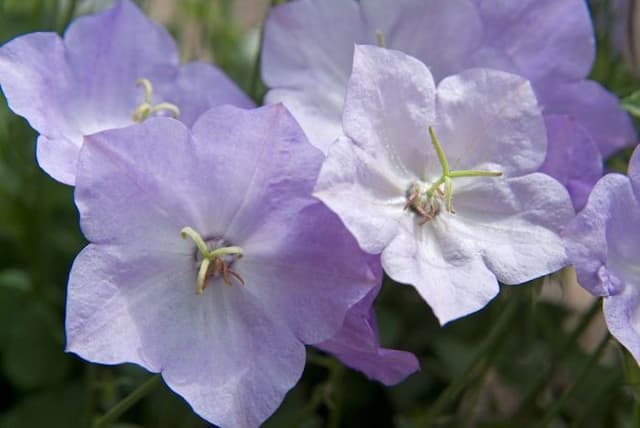Campanula latifolia 'Brantwood'

ABOUT
The plant known as the 'Brantwood' variety of Giant Bellflower has a striking appearance characterized by its display of deep violet-blue, bell-shaped flowers. These flowers are notable for their sizable shape and their arrangement in clusters along the upper portion of the plant's stems. The texture of the petals is delicate and soft to the touch, providing a beautiful contrast with the surrounding greenery. The foliage of the 'Brantwood' is comprised of broad, heart-shaped leaves that are rich in color, ranging from mid to dark green, creating a lush backdrop that further accentuates the vibrant floral display. This variety of Giant Bellflower has a stately and elegant bearing, with a sturdy, upright habit that showcases its flowering stems prominently. The overall look of the plant is one of dignified beauty, making it a popular choice for gardeners looking to add a touch of mesmerizing color and classic charm to their gardens.
About this plant
 Names
NamesFamily
Campanulaceae.
Synonyms
Giant Bellflower, Wide-leaved Bellflower, Broad-leaved Bellflower.
Common names
Campanula latifolia 'Brantwood'.
 Toxicity
ToxicityTo humans
The plant known commonly as giant bellflower is not typically known to be toxic to humans. Therefore, if the giant bellflower is ingested by humans, there are no well-documented symptoms of poisoning associated with this plant. While it is generally considered non-toxic, it is always advisable to avoid ingesting plants not meant for consumption, as they could potentially cause mild stomach upset or an allergic reaction in some individuals.
To pets
The giant bellflower is also not considered toxic to pets. It should not cause any significant symptoms of poisoning if ingested by animals such as cats and dogs. As with humans, while the giant bellflower is generally safe, it is best practice to prevent pets from consuming non-food plants, as individual reactions can vary and there could be a risk of gastrointestinal upset or an allergic reaction.
 Characteristics
CharacteristicsLife cycle
Biennials
Foliage type
Deciduous
Color of leaves
Green
Flower color
Purple
Height
4-5 feet (1.2-1.5 meters)
Spread
1-2 feet (0.3-0.6 meters)
Plant type
Herb
Hardiness zones
5
Native area
Europe
Benefits
 General Benefits
General Benefits- Aesthetic appeal: The bellflower, with its striking blue-violet flowers, adds visual interest and beauty to any garden space.
- Attracts pollinators: Its blooms are known to attract bees, butterflies, and other beneficial insects that are essential for pollination.
- Low maintenance: The bellflower is relatively easy to care for, requiring minimal watering and pruning.
- Cold-hardy: This plant is capable of withstanding colder temperatures, making it suitable for gardens in temperate regions.
- Shade tolerance: It can thrive in partially shaded areas where other flowers may not grow as well, offering flexibility in garden design.
- Perennial growth: As a perennial, it returns each year, reducing the need for replanting and providing long-term garden structure.
 Medical Properties
Medical PropertiesThis plant is not used for medical purposes.
 Air-purifying Qualities
Air-purifying QualitiesThis plant is not specifically known for air purifying qualities.
 Other Uses
Other Uses- Campanula latifolia, commonly known as the giant bellflower, can be used in fabric dyeing, giving a sense of creativity and uniqueness to textiles with its potential to produce soft shades of blue or green.
- The dried stems and flowers of the giant bellflower can be incorporated into potpourri mixtures for a delicate fragrance and to add a touch of nature to your home decor.
- Giant bellflower's large leaves can be used as natural wrappers for small gifts or homemade herbal sachets, providing an eco-friendly packaging option.
- The robust structure of the giant bellflower makes it suitable for creating floral support structures in the garden, helping other weaker-stemmed plants to stand tall.
- With its tall and elegant appearance, the giant bellflower can serve as a natural backdrop in photography, especially in garden and nature-inspired shoots.
- The giant bellflower can be used in educational settings, such as schools or botanical workshops, for studies on pollinator attraction and plant biology due to its appeal to bees and butterflies.
- When dried and pressed, the flowers and leaves of Campanula latifolia can be used in crafting, such as in scrapbooking, greeting card decoration, or botanical art projects.
- Dried giant bellflower petals can be used as confetti in eco-friendly celebrations, providing an all-natural and biodegradable alternative to traditional paper or plastic products.
- The plant can function as a natural soil stabilizer in gardens or outdoor spaces prone to erosion due to its ability to form dense foliage and root systems.
- Creative gardeners can utilize the rigid stems of the giant bellflower to construct tiny, whimsical fairy garden accessories or miniature garden stakes.
Interesting Facts
 Feng Shui
Feng ShuiThe Giant Bellflower is not used in Feng Shui practice.
 Zodiac Sign Compitability
Zodiac Sign CompitabilityThe Giant Bellflower is not used in astrology practice.
 Plant Symbolism
Plant Symbolism- Enduring Love: The bell-shaped flowers of the Campanula, or bellflower, are often seen as symbols of unending love due to their ability to bloom year after year.
- Gratitude: Campanula can also represent gratitude, making it a perfect gift to express appreciation towards someone.
- Constancy: The steadfast nature of the bellflower, which reliably flowers each season, symbolizes constancy and faithfulness in relationships.
 Water
WaterThe Giant Bellflower requires even moisture, and it's essential to water it when the top inch of soil feels dry to the touch. Generally, this means watering approximately once a week, but this can vary depending on factors such as temperature and humidity. While it’s important not to let the soil dry out completely, it's also crucial to avoid waterlogging the plant, as this can lead to root rot. Apply water directly to the soil around the plant until it's evenly moist, and ensure that any excess water can drain away easily. In terms of quantity, start with about half a gallon of water per plant and adjust based on the plant's response and the weather conditions.
 Light
LightThe Giant Bellflower thrives in partial shade to full sun conditions. A location that receives morning sun and afternoon shade is ideal for this plant, especially in hotter regions. While adaptable, excessive shade may lead to leggy growth and poor flowering, whereas too much direct sun can stress the plant, particularly in the heat of midday. Ensure it receives at least four to six hours of sunlight daily for optimal growth.
 Temperature
TemperatureThe Giant Bellflower can tolerate a range of temperatures but grows best in environments where the average is between 60-70 degrees Fahrenheit. It can survive minimum temperatures down to around 50 degrees Fahrenheit and can handle brief periods of colder temps down to about 40 degrees. This plant prefers cooler conditions, and high temperatures above 80 degrees Fahrenheit can be challenging, so it's best to provide some shade during the hottest part of the day during peak summer months.
 Pruning
PruningPrune the Giant Bellflower to maintain its shape, encourage bushier growth, and promote more blooms. Deadhead spent flowers regularly to stimulate new blooms. Cut back the stems after flowering has finished to tidy up the plant and encourage a second flush of blooms in the same season. The best pruning time is immediately after the first flowering peak has subsided, typically in late spring or early summer. Additionally, light pruning in the spring can also help remove any dead or damaged growth that occurred over the winter.
 Cleaning
CleaningAs needed
 Soil
SoilThe Giant Bellflower thrives best in a soil mixture that is rich, moist, and well-drained with a pH ranging from neutral to slightly alkaline (pH 6.5-7.5). A good mix would be one part loam, one part peat moss or compost, and one part sharp sand to promote good drainage.
 Repotting
RepottingThe Giant Bellflower does not require frequent repotting and can typically be repotted every 2-3 years. It is best to repot in the spring before the onset of new growth.
 Humidity & Misting
Humidity & MistingThe Giant Bellflower prefers moderate humidity levels but is quite adaptable. It will thrive in average room humidity, avoiding both excessively dry and overly humid environments.
 Suitable locations
Suitable locationsIndoor
Provide bright light, keep soil moist, and ensure good ventilation.
Outdoor
Plant in partial shade, enrich soil, mulch, and water regularly.
Hardiness zone
3-8 USDA.
 Life cycle
Life cycleThe life of Campanula latifolia 'Brantwood', commonly known as the Giant bellflower, begins with seed germination, typically in spring when soil temperatures become warm enough. After germination, the seedling stage follows where the plant develops its first true leaves and root system. As it enters the vegetative stage, it produces more leaves and stems, gathering energy through photosynthesis and growing taller. Once it reaches maturity, the Giant bellflower enters the flowering stage during early to mid-summer, showcasing tall spikes with large, bell-shaped blue-violet flowers that attract pollinators. Following pollination, the plant sets seeds, which are dispersed by wind or fall near the parent plant. Finally, the plant enters dormancy in late summer to autumn, reducing above-ground activity but surviving through its perennial root system until the next growing season.
 Propogation
PropogationPropogation time
Spring to Early Summer
The Giant Bellflower, or Campanula latifolia 'Brantwood', is a popular perennial that is best propagated by division, a method that allows gardeners to create new plants by separating the roots of a mature plant. The ideal time for dividing and transplanting Giant Bellflower is in the spring as the plants emerge from dormancy or in the early fall when the summer heat has passed. During propagation by division, carefully dig around the plant to lift the root ball from the ground. It is important to preserve as much of the root system as possible during this process. Using a sharp spade or knife, cleanly cut through the root clump to create smaller sections, ensuring that each section has a portion of roots attached. These individual divisions can then be replanted in well-prepared soil, spaced at intervals to allow for future growth, and watered thoroughly to help establish the new plants. It's crucial to maintain regular watering until the new divisions are well established, especially if the transplanting takes place during a dry period.









![Milky bellflower [Avalanche]](/_next/image?url=https%3A%2F%2Fplants-admin.emdemapps.com%2Fimages%2Fplants%2F%2Fimages%2F604b5dc88c1e7.png&w=640&q=75)